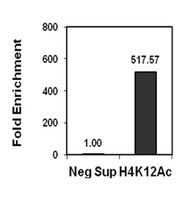04-119-S Sigma-AldrichAnti-acetyl-Histone H4 (Lys12) Antibody, Trial Size, rabbit monoclonal
This Anti-acetyl-Histone H4 (Lys12) Antibody, Trial Size / Pack is validated for use in WB for the detection of acetyl-Histone H4 (Lys12).
More>> This Anti-acetyl-Histone H4 (Lys12) Antibody, Trial Size / Pack is validated for use in WB for the detection of acetyl-Histone H4 (Lys12). Less<<Prodotti consigliati
Panoramica
| Replacement Information |
|---|
Tabella delle specifiche principali
| Species Reactivity | Key Applications | Host | Format | Antibody Type |
|---|---|---|---|---|
| H | WB, DB, ChIP | Rb | Culture Supernatant | Monoclonal Antibody |
| Description | |
|---|---|
| Catalogue Number | 04-119-S |
| Trade Name |
|
| Description | Anti-acetyl-Histone H4 (Lys12) Antibody, Trial Size, rabbit monoclonal |
| Alternate Names |
|
| References |
|---|
| Product Information | |
|---|---|
| Format | Culture Supernatant |
| Presentation | 10 μL of rabbit monoclonal IgG cell culture supernatant with 0.1% sodium azide. |
| Quality Level | MQ100 |
| Physicochemical Information |
|---|
| Dimensions |
|---|
| Materials Information |
|---|
| Toxicological Information |
|---|
| Safety Information according to GHS |
|---|
| Safety Information |
|---|
| Storage and Shipping Information | |
|---|---|
| Storage Conditions | 2 years at -20°C from date of shipment |
| Packaging Information | |
|---|---|
| Material Size | 10 µL |
| Transport Information |
|---|
| Supplemental Information |
|---|
| Specifications |
|---|
| Global Trade Item Number | |
|---|---|
| Numero di catalogo | GTIN |
| 04-119-S | 04053252907456 |
Documentation
Anti-acetyl-Histone H4 (Lys12) Antibody, Trial Size, rabbit monoclonal MSDS
| Titolo |
|---|
Anti-acetyl-Histone H4 (Lys12) Antibody, Trial Size, rabbit monoclonal Certificati d'Analisi
| Titolo | Numero di lotto |
|---|---|
| Anti-acetyl Histone H4 (Lys12), Trial Size - 2564034 | 2564034 |
| Anti-acetyl Histone H4 (Lys12), Trial Size - 3766681 | 3766681 |
| Anti-acetyl Histone H4 (Lys12), Trial Size - Q2187990 | Q2187990 |

















